
| Palaeos |  |
Malacostraca |
| Arthropoda | Isopoda |
| Page Back | Unit Up: Arthropoda | Unit Home | Clade Up: Peracarida | Page Next |
| Unit Back: Ostracoda | Clade Down: None | Dendrogram | References | Unit Next: Decapoda |
|
Abbreviated Dendrogram
CRUSTACEA |--Phosphatocopida `--+--Branchiopoda |--Remipedia `--+==Maxillopoda |--Ostracoda `--MALACOSTRACA |--Phyllocarida `--+--Hoplocarida `--Eumalacostraca |--Syncarida |--Peracarida | |--Pygocephalomorpha | |--Mysida | `--+--Amphipoda | `--Isopoda `--Eucarida |
Contents
Overview |
Taxa on This Page
This content on this page copied verbatum from Encyclopedia of Earth - Crustacea under Creative Commons Attribution Share-Alike license. It is intended at some point to add additional material on evolution, paleontology, etc MAK120517
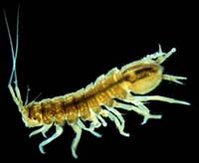 (Source: Biodiversity Institute of Ontario) |
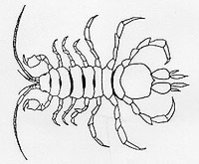 (Source: Biodiversity Institute of Ontario) |
With over 10,000 species, the order Isopoda is the second most diverse group of crustaceans. Isopods can be found in all types of habitats, but most species live in the sea or on land. Looking under garden rocks or rotting logs, you will often discover them. They are the small, hard-shelled creatures which resemble miniature armadillos, that roll into a tiny ball when disturbed. You might know them as rolly-pollys, or sow bugs. The most striking characteristic of isopods is their dorsoventral compression.
 (Source: Biodiversity Institute of Ontario) |
The body of isopods is divided into three sections; the cephalothorax, the thorax and the abdomen. The compound eyes of isopods are dorsal and unstalked. Isopods are negatively phototactic (reathey ct to light by moving away from it), and usually remain hidden under rocks and debris. Their first antennae are short, while the second set is much longer and reach ahead of the isopod to "feel' for signs of food sources as well as potential danger. The first pair of legs are called gnathopods ("jaw-feet") because they are modified for grasping and tearing food. The other thoracic segments each bear a pair of walking legs. The last abdominal segment is a result of the fusion of the last four abdominal segments to form a posterior shield in all North American species. Uropods are the last pair of abdominal appendages that are biramous and extend beyond the end of the abdomen. Mature females have large, inwardly directed, platelike oostegites at the inner base of their anterior (front) legs. They form a shallow chamber on the ventral surface of the thorax called a marsupium. It serves to hold and protect developing eggs or young.
 (Source: Biodiversity Institute of Ontario) |
 (Source: Biodiversity Institute of Ontario) |
Isopods reproduce sexually and breeding occurs throughout the year. Thus, egg-bearing females may be found year-round, but most are found during the spring and summer months. During mating, males grasp females and carry them under their bodies using their periopods. They may remain attached for months. The male presses his ventral surface against the side of the female, placing his genital pores close to one of the female's genital pores. Sperm are released while the male pleopods vibrate rapidly. The male then moves to the other side of the female and repeats the process with the other genital pore. After 1 to 10 months, the eggs are fertilized and pass into the marsupium. The incubating eggs and newly hatched young remain in the marsupium for up to one month. The newly hatched first instar young look much like miniature versions of the adult. The number of instars in unknown, but there are thought to be at least 15 before maturity is reached. Most freshwater isopods have a lifespan of approximately one year.
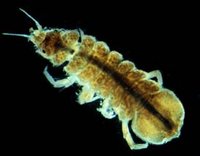 (Source: Biodiversity Institute of Ontario) |
Freshwater isopods are primarily benthic and occur in the littoral zone of ponds, lakes, streams and springs, but they have been recorded at depths of as much as 55 m. They are the poorest swimmers of all freshwater crustaceans. In fact, they can barely swim at all and locomotion is usually restricted to a slow crawl. For this reason, they are exclusively associated with the substrate, or aquatic macrophytes where they live a somewhat secretive existence. Most species are scavengers, feeding primarily on dead and injured organisms, as well as green, decaying vegetation. As a result they form an important link in food chains by recycling dead and decaying material back into living tissue. Isopods have also been shown to be an important food item in the diet of many stream fishes.
The tongue-eating isopod, Cymothoa exigua, lives in the mouth of the rose snapper (Lutjanus guttatus) and causes tongue stub and the floor of the fish's mouth and resembles the missing tongue! -- Encyclopedia of Earth - Crustacea
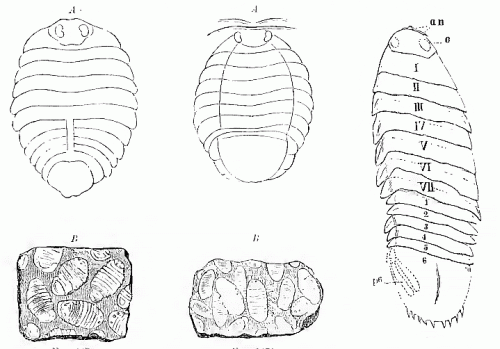 Fossil isopods. Left, A, Archaeoniscus brodei Purbeck, Wiltshire. B, Fragment of matrix. Center Eusphaeroma brougniarti, Middle Oligocene, Butte de Chaumont, near Paris, B, Fragment of matrix, i; Right Palaega scrobiculata. Early Oligocene; Tyrol, Austria, Abbreviations: an. Antennae ; o, Eyes ; p6, Uropod ; I-VII, Thoracic segments ; 1-6, Abdominal segments. Zittel & Eastman 1913. |
Of the earlier fossils that have been referred to this group, Oxyuropoda from the Devonian of Ireland, has previously been considered the earliest Isopod. but seems to be a more primitive form; the similarity due to convergence.
Undoubted Isopods appear in Mesozoic, Urda from the Kimmeridgian Solenhofen lagestatte, has some peculiar characters in which it approaches the males of the Recent Gnathia, although differing in the large size of the eyes. Cyclosphaeroma, from the Jurassic (Great Oolite and Purbeck), resembles in general form some Recent members of the family SiDhaeromidae, as do also Archaeoniscus from the English Purbeck (Latest Jurassic/Earliest Cretaceous) and Eosphaeroma from the Eocene and Miocene. Palaega Cenomanian and Oligocene, resembles the Recent Aega and allied genera. Proidotea from the Oligocene of Romania, is closely allied to the Recent Mesidotea in the tribe Valvifera.. - Zittel & Eastman 1913, slightly modified MAK120517
Range: From the Permian
Characters: Body usually broad and depressed. Carapace absent; first thoracic somite, rarely also the second, fused with the head. Abdomen short, the last somite almost always coalesced with the telson. Eyes sessile. Thoracic limbs without exopodites. Abdominal limbs lamellar, branchial - Zittel & Eastman 1913
Comments: Terrestrial pill bugs and their marine relatives. Cyclosphaeroma (Jurassic) and Sphaeroma (Recent) are representatives - Twenhofel & Shrock 1935
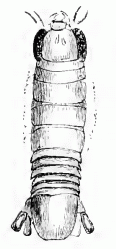 Urda rostrata Kunth, 1870, from the Lithographic Stone, Solenhofen, Bavaria (Early Tithonian). This species is distinguished by the large lateral eyes, frontally protruding mandibles, Image from Zittel & Eastman 1913
Urda rostrata Kunth, 1870, from the Lithographic Stone, Solenhofen, Bavaria (Early Tithonian). This species is distinguished by the large lateral eyes, frontally protruding mandibles, Image from Zittel & Eastman 1913
| Page Back | Unit Home | Page Top | Page Next |
From "Crustacea", Encyclopedia of Earth. Eds. Cutler J. Cleveland (Washington, D.C.: Environmental Information Coalition, National Council for Science and the Environment) 100219; revised 110529; Creative Commons Attribution Share-Alike